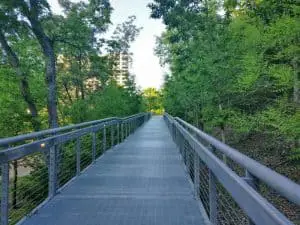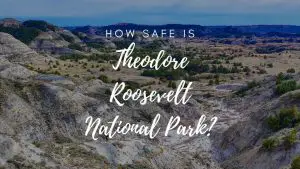Is Lake Clark National Park Safe? (2023)

Lake Clark National Park is located in Alaska and is known for its stunning landscapes and wildlife. The park is a popular destination for hikers and outdoor lovers.
But is Lake Clark National Park Safe?
Yes, Lake Clark National Park is safe. There are some concerns and safety risks to be aware of when hiking in the park, but these can be easily avoided by taking some precautions. We will address the concerns and safety risks of Lake Clark National Park in this blog post.
Quick Links
What Are The Biggest Dangers At Lake Clark National Park?
Lake Clark National Park is one of the most popular national parks in the United States. Every year, many people come to this park to enjoy its beautiful scenery and wildlife.
However, there are also some dangers that hikers and outdoor lovers should be aware of, which include rough terrain, weather, and to a lesser extent – wildlife.
In this article, we’ll take a look at some of the biggest dangers at Lake Clark National Park. We’ll discuss the dangers posed by the terrain, the wildlife, and the weather. We’ll also provide some tips on how to stay safe while enjoying the park.
Is Lake Clark National Park Safe At Night?
One of the best things about hiking and exploring national parks is that you can do it at any time of day or night. However, it is important to be aware of the dangers that come with hiking at night. Low visibility, more wildlife out at night, and uneven terrain are just some of the dangers that hikers need to be aware of.
Here are some specific night-time dangers to be aware of when hiking in Lake Clark National Park:
- bears are active at night and can be attracted by food
- moose are more active at night and can be aggressive
- it is easy to get lost in the dark
Here are some tips to stay safe while exploring Lake Clark National Park at night:
- hike with a friend or group
- make noise to avoid surprise encounters with wildlife
- carry a flashlight
- stay on marked trails
- be aware of your surroundings at all times
Is It Safe To Go Alone To Lake Clark National Park?
There are many risks associated with hiking alone, but that doesn’t mean you shouldn’t do it. Hiking is a great way to get some exercise and enjoy the beauty of nature, but you should always be aware of your surroundings and take precautions. Make sure you let someone know where you’re going and when you expect to be back, and carry a map and a compass. It’s also a good idea to hike with a friend whenever possible.
There are a few things to be aware of when hiking in Lake Clark National Park. The terrain can be challenging, with steep cliffs, rugged mountains, and deep valleys. There are also a lot of rivers and lakes, so make sure you know how to swim if you’re planning on hiking near them. And of course, there are bears in the park. Bears are generally not aggressive, but you should always be careful when hiking in bear country. Make sure you make noise as you hike, so you don’t startle any bears that might be nearby.
Is It Safe To Drink Water In Lake Clark National Park?
It’s no secret that water is essential to our survival. We need to drink it every day to stay hydrated and healthy. But what happens when you’re out in the middle of nowhere, and the only water source is a dirty lake? Is it safe to drink water from Lake Clark National Park?
Generally speaking, it’s not safe to drink untreated water from any natural water source. This includes lakes, rivers, streams, and ponds. The water may look clean, but it can be contaminated with bacteria, viruses, and parasites that can make you sick. Hikers and campers should always purify their water before drinking it to kill any harmful microbes.
There are a few different ways to purify water. The most common method is to boil water for at least one minute. This will kill most bacteria and viruses. You can also use a water filter or purifier. These devices are designed to remove harmful microorganisms from water. Some filters can even remove chemical contaminants.
If you’re hiking or camping in Lake Clark National Park, it’s important to purify your water before drinking it. This will help you avoid getting sick from harmful microorganisms that might be in the water. Boiling water for one minute is an effective way to kill most bacteria and viruses. You can also use a water filter or purifier.
The Wildlife Of Lake Clark National Park
Lake Clark National Park is home to a variety of wildlife. Some of the most common animals you may see while hiking through the park include:
If you do encounter a bear, it is important to stay calm and make as little noise as possible. Move away slowly, and do not run. If the bear does not see you as a threat, it will likely move on. If the bear does see you as a threat, make yourself as small as possible and back away slowly. Do not drop food or other items, as this may attract the bear. If the bear does attack, fight back with everything you have.
Wolverines are another animal you may encounter while hiking through Lake Clark National Park. These animals are generally shy and will avoid humans if possible. However, if you do encounter a wolverine, do not approach it. Give the animal plenty of space, and do not attempt to feed it. If the wolverine does become aggressive, make yourself as small as possible and back away slowly. Do not run, as this will trigger the wolverine’s predatory instincts.
There are also a variety of birds that call Lake Clark National Park home. Some of the most common include:
- bald eagles
- ptarmigan
- ravens
- spruce grouse
- willow ptarmigan
If you see any of these birds while hiking, enjoy watching them from a distance. Do not attempt to feed them, as this can disrupt their natural eating habits.
Hiking Safety Tips For Lake Clark National Park
When hiking Lake Clark National Park, it is important to be aware of your surroundings and take precautions to ensure your safety. Here are some tips to help you stay safe while enjoying the great outdoors:
- Be aware of your surroundings at all times. This means being aware of the terrain, weather conditions, and other hikers on the trail.
- Make sure you are properly prepared for your hike. This includes having the proper equipment, clothing, and food.
- Stay on the trail, and do not wander off. This will help you avoid getting lost and will also help protect the environment.
Conclusion
In conclusion, although Lake Clark National Park is safe, there are a few precautions that should be taken. Hikers should be aware of the possibility of encountering bears and should take the necessary precautions. They should also be aware of the possibility of encountering other dangerous wildlife, such as moose. Overall, however, Lake Clark National Park is a safe place to hike and enjoy the outdoors.







